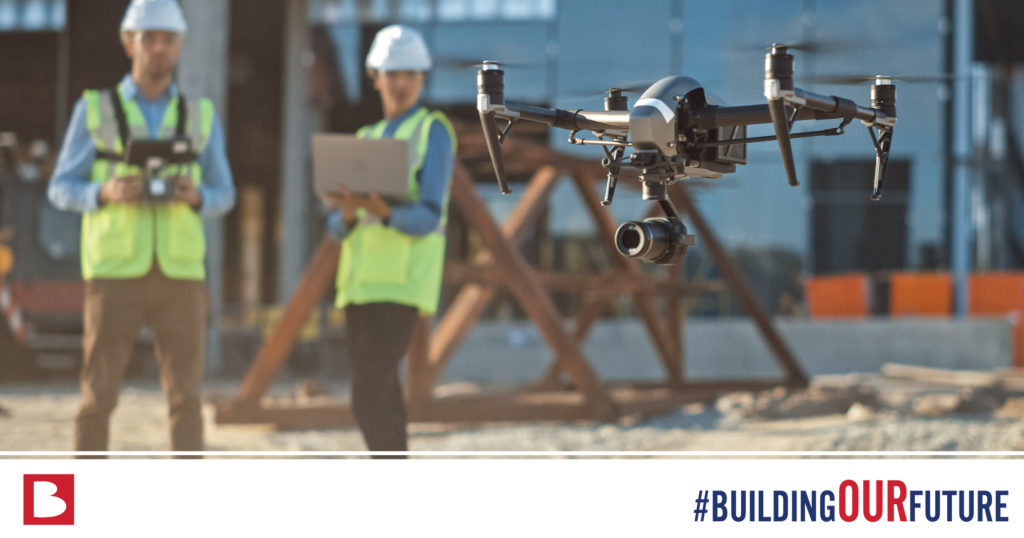2020 saw unprecedented changes in the commercial construction industry. The COVID-19 pandemic led to international supply chain shortages, workforce challenges, industry need shifts, and the task of finding new ways to operate in a rapidly different world. Couple this with technological disruptions in the industry and a cultural shift towards sustainable building to create a wave of innovation in our near future.
Technological advancements combined with retooled tried and true methods are the key to staying ahead of the transition as the world continues to change even after the COVID-19 pandemic resolves.
Machine Control Saves Time, Money, and Fuel on the Job Site
Machine Control is the use of various positioning sensors and a display to provide the operator with a reference between the position of the bucket or blade and the target grade. Machine control hardware was initially developed using data from satellites, total stations, and 3D models to ensure machine operators accurately positioned machinery, check grade, automate equipment functions and collect data. Used by the construction industry since the late 1990’s, this technology continues to evolve to meet industry demands.
Using an Automatic Grade Control System (GPS) surveyors can share their information with the sensors located on the equipment to guide operators to cut the right depth, grade and slope every time. This eliminates the need to manually stake out the required grade.
Implementing Software Programs Streamlines Communication
We all know that effective communication can break or make a project. Utilizing project management software eliminates any disconnect between the office and field. Being able to communicate any changes, potential issues or address questions in real time can save significant time resulting in tangible results.
Compared to the traditional paper-based system, blueprints can now be stored and shared using cloud-based systems like Plan Grid. This seemingly simple change can save days and allows superintendents to send real time updates to the entire project team including architects and subcontractors.
True Collaboration from Start to Finish
There are also software programs available like Building Information Modeling (BIM) that is used to design and document the building process. By building a 3-D model of the structure before you build it you can more effectively evaluate the constructability of the design. This reduces the need for rework which can cause delays to the schedule or even unplanned budget increases.
Drones Improve Workplace Safety and Efficiency
In the past, aerial photos and construction site flyovers were costly and inefficient. Drones are an inexpensive way to pick up this task and so much more. In fact, drones are now used in most parts of the construction process.
Drones in construction are quick and small, which also allows for them to easily reach peaks of dangerous terrain or highly trafficked sites. Whether a building inspection or safety inspection, drones are essentially eliminating non-accessible areas. For example, OSHA has used drones only with employers’ permission, at worksites where an accident occurred, and the area was considered too dangerous for inspectors to enter (such as collapsed buildings, chemical fires and oil rigs). Departments of Transportation in various states utilize drones to perform bridge and road inspections that keep their inspector out of harm’s way.
Modular and prefabricated construction
Modular and prefabricated construction practices are not new but have seen a resurgence to combat labor shortages and reduce overall construction time and costs.
Prefabricated construction components are manufactured off-site before being installed in the final building. ‘Prefab’ components can be as simple as walls, floors, stairs or, in the case of modular components, be entirely finished rooms. These elements can be combined with on-site construction elements or entire structures can be erected using only prefabricated parts.
In 2020, we saw labor shortages exacerbated by the COVID-19 pandemic and this trend is continuing into 2021. The use of prefabricated components and modular construction allows for buildings to be erected with a high level of cost and time predictability, less waste, and with more efficiency than trying to perform the same work with more limited crews.
As modular and prefab construction continues to gain more of a foothold in the industry, we will see more prevalent use in educational buildings, offices, retail, healthcare, and hotels.
Sustainable buildings and materials
Sustainability has been steadily on the rise in commercial construction, but the 2020 COVID-19 pandemic heightened the environmental awareness of the public. With a wealth of incentives like the Federal Investment Tax Credit, rising energy costs, consistent media coverage of climate change, and lowered cost on sustainable materials, eco-friendly construction will see a surge in the ’20s.
Some of the efforts on the green building front include:
LEED-Certified construction
LEED (Low in Energy and Environmental Design) construction is a widely used rating system seen worldwide. These buildings are designed to conserve energy, water, and resources. While this framework has been around for more than 25 years, the popularity of eco-friendly tax credits and the current public goodwill that comes from green buildings is expected to drive clients to request projects to be LEED-certified more than ever before.
Insulated concrete forms
ICF are not only quick to build but provide an energy-efficient barrier to the outside elements that keeps indoor temperatures consistent. These sturdy forms are also resilient to natural disasters and severe weather.
Solar panels
Solar panels aren’t necessarily new, but their accessibility to the public is. The cost of solar panels has dramatically decreased by over 70% in the last ten years. With added tax incentives for businesses and an unprecedented demand for renewable energy, solar panels will be common additions to new construction in the coming years.
Smart glass
Smart glass, also known as electrochromic glass, allows for large buildings to better manage their energy use by shielding the interior from sunlight during the summer and letting more light in during the winter. This allows for better natural regulation of the building interior and keeps energy demand down.
This glass is versatile and can be used in many settings, but is most commonly seen in schools, commercial buildings, corporate buildings, hotels, hospitals, and even retail stores. Its most common placement is in windows but can also be used for skylights or even in interior projects to protect items from harmful UV light.
Continued search for eco-friendly alternatives
As the green building movement continues to boom, the industry will see a look towards innovation. Eco-friendly alternatives, especially for common building materials like steel and concrete, can reduce worldwide carbon emissions and a deeper awareness of building materials and environmental impacts could help improve interior and exterior air quality.
This year, we’re seeing a mass return to older building methods like timber in an effort to use more sustainable materials and reduce construction carbon footprints.
In the end, 2021 is focused on a few key areas: safety, sustainability, and efficiency. As we recover from COVID-19 and move forward to a life after the pandemic, the industry may look a little different, but the end goal is the same: to build on-time, on-budget, and as safely as possible.


